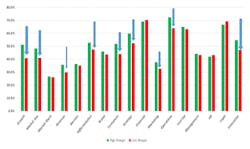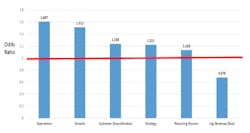In a recent post, I examined the differences in productivity across small and large manufacturing firms and noted that there were differences across manufacturers in terms of size, but it is also clear from the literature that productivity differs across companies even in the same industry.
Why are some companies more productive than others?
While the differences across firms in terms of productivity is well documented (Syverson, 2011), less attention has focused on what factors may account for these differences. Do these differences reflect idiosyncratic factors specific to a firm or are they related to systematic factors that one can control and change (Bloom, et al, 2013)? Bloom and his colleagues, for instance, found that management practices were positively and strongly related to a range of performance measures including productivity, profitability, growth, exporting, and innovation. Management matters, of course, but how? Is operational excellence (in terms of internal characteristics such as markets, management systems, strategy) associated with better performance? Does management matter to company performance?
Strategy, Operational Excellence, and Markets Matter
Following on this work, I decided to stick my toe into that world of research and presented a paper at the 2016 Industry Studies Association meeting in Minneapolis, MN, using a set of proprietary data (Core Value™). Core Value™ has collected data on several thousand small and mid-sized firms across the U.S. My analysis found that factors such as strategy, operational excellence, and markets did matter.
The Core Value™ data provides information on self-assessments of firms on 18 dimensions of operational practices and related information on business outcomes including productivity, gross revenue and net income (as measured by EBITDA). I created groupings of firms into high and low performance categories based on median profit margin and sales per employee. Firms above the median were coded as 1 (high performers) and firms below median were coded as zero (low performers) and then created a series of dummy variables based on self-assessment across 17 dimensions.
Businesses at or near best practice were coded with a 1 and all others were coded as 0. I also compared a combined management score based on 17 dummy variables and an average score (management score/17). Simple correlations between best practice groupings on each measure and the high/low performance groupings indicated that variables such as growth, market size, customers, strategy, operations, and innovation were positive and significantly related to better performance. The chart below highlights the differences across the groups in terms of the share of firms that had above or below median performance in terms of profit margin and the blue arrows indicate those areas where the differences were statistically significant.
Differences in Best Practices Across Hi-Low Profit Margin Groups (N = 1,456)
However, I was not satisfied with these simple correlations and chi-square tests. I’m that way. I wanted to run a model that controlled for all these factors (and a few others) and turned to multivariate modelling. I ran a series of logit models and the following factors had significant (and sometimes positive) impacts on the probability of predicting high and low performance. The results are highlighted in the chart below and identify those factors that were statistically significant related to high performance. For instance, I highlight what we found in terms of profit margin.
The Importance of Management
Management and markets matter. Strategy, growth orientation, operational performance, and diversified customer base are all likely to boost profit performance significantly. Size does matter. But, bigger is not always better. Size is negatively related to profit margin, but positively related to sales per employee. Market share and size is negatively related to above average sales per employee performance. Product differentiation, strategy, and operational performance boost sales per employee.
Odds Ratio: Profit Margin Predictors
These findings, while suggestive, also reinforce other studies. For instance, The State of Manufacturing 2016 conducted by Enterprise Minnesota found that “companies that operate from a strategic plan are more confident about their financial prospects than those that don’t. (p.11). In addition, the same study held focus groups with manufacturers across Minnesota.
It’s not enough to say that organizational performance varies; we also need to examine why an organization performs as it does to develop prescriptions for improvement. From a research and assistance perspective, the second question can be addressed by examining the effect of organizational structure, strategies, resources, service models, external environment factors, and internal factors including management practices and behaviors on performance. What can an organization’s managers, employees, and technical assistance providers do to improve performance? That’s the challenge and the opportunity.
This article was originally posted on Manufacturing Innovation Blog is powered by The Manufacturing Extension Partnership.


